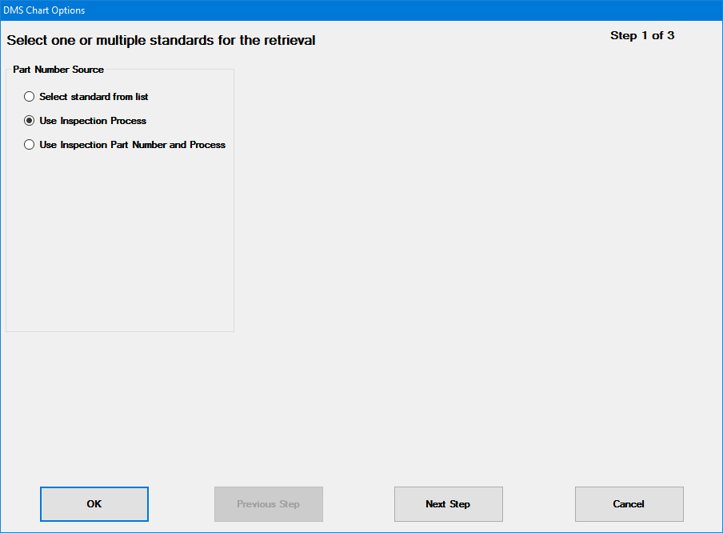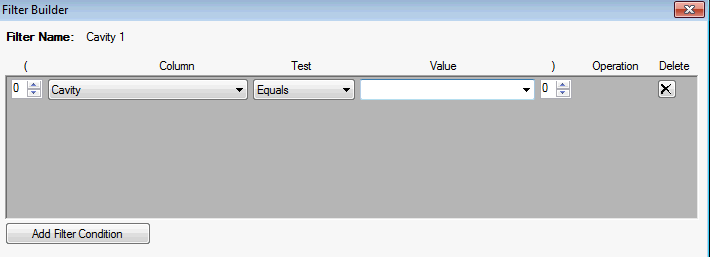
The DMS Chart Options window lets you configure charts to display on the current sub-inspection. For information on opening this window, see Setting charts to display in inspections.
If you want this sub-inspection to chart multiple standards with the same chart types and chart settings (date period, filter, statistical settings, etc.), you can use this step to select all those standards at once – beginning with the Part Number Source:
Select standard from list: Use this option to choose specific standard(s) or process(es) – regardless of any DMS Standard tests in the inspection, and regardless of the Process property of the inspection. For more information, see Selecting Part Numbers or Processes.
Use Inspection Process: Use this option to select the Process specified in the Process property of the inspection.
Use Inspection Part Number and Process: Use this option to select the standard specified in the current DMS Standard test for this sub-inspection.
When finished selecting standards, click Next Step.

Select the DMS chart types you want to display, and then click Next Step.


Choose retrieval and statistical settings for the standards and charts you have selected. You can also specify a Chart skin (created in the GainSeeker Charts module) that changes display options for these charts. When finished, click Save and Close.
 Note: If you display a Statistics
List or Statistics Table, GainSeeker will use the default report name
from the current Chart skin (if specified) or from the current GainSeeker
configuration. If a default Statistics list or Statistics table report
name is not specified in either of these areas, GainSeeker will simply
display system default statistics on these charts.
Note: If you display a Statistics
List or Statistics Table, GainSeeker will use the default report name
from the current Chart skin (if specified) or from the current GainSeeker
configuration. If a default Statistics list or Statistics table report
name is not specified in either of these areas, GainSeeker will simply
display system default statistics on these charts.
 Tip: If desired, you can configure
the charts with a special filter for data that matches traceability values
in this inspection:
Tip: If desired, you can configure
the charts with a special filter for data that matches traceability values
in this inspection:
In some cases, you may wish to filter the chart for a traceability value that was entered in this inspection – by a Traceability test in a previous sub-inspection or the current sub-inspection, a Planned Inspection, or a Formula test (using inspect.cursubi.trace(idx).value or inspect.settracevalue Python commands).
For example, you might wish to filter for:
a Lot number that the user enters during data entry
a Machine ID that you preset with a Planned Inspection or Formula test
To filter for such a traceability value – which may vary from one data entry session to the next – you must create a saved filter that looks for a blank value in that traceability field, such as this example which filters for the current Cavity number:

If this traceability value is not set before the sub-inspection with the filter is opened, the charts that use this filter will not be drawn until a value has been set for this traceability field.
When you use the ChartOptionsDMS property of a sub-inspection to set up charts, the timing for creating those charts depends on how the standard or process for those charts is defined.
When standards or processes are selected using one of these methods, the corresponding chart will be created immediately when the sub-inspection opens:
When setting the sub-inspection property ChartOptionsDMS, the Part Number Source is set to Select standard from list
When setting the sub-inspection property ChartOptionsDMS, the Part Number Source is set to Use Inspection Process, and one of the following criteria is met:
The Inspection has the Process property set to a particular process
A Planned Inspection is used to select a different process for the Inspection
When setting the sub-inspection property ChartOptionsDMS, the Part Number Source is set to Use Inspection Part Number and Process, and one of the following criteria is met:
This sub-inspection does not contain a DMS Standard test, because the DMS Standard is set by a previous sub-inspection
This sub-inspection
contains a DMS Standard test with the DMSStandard
property set to a particular standard
 Please note: If the DMSStandard
property contains a value that does not match an existing
DMS standard, the inspection will still generate a chart
for that "value".
Please note: If the DMSStandard
property contains a value that does not match an existing
DMS standard, the inspection will still generate a chart
for that "value".
This sub-inspection contains a DMS Standard test, and a Planned Inspection is used to select a different DMS standard for this sub-inspection
This sub-inspection contains a DMS Standard test, and it also contains a Formula test with the FormulaMode property set to Pre and the PythonScript property set to a script that uses the inspect.cursubi.dmspart(idx).partnumber command to set a different standard
When all of the following criteria are met, the chart for a standard will be created immediately after the data entry user selects the standard:
When setting the sub-inspection property ChartOptionsDMS, the Part Number Source is set to Use Inspection Part Number and Process
This sub-inspection contains a DMS Standard test with the DMSStandard property left blank
If the user later selects a different standard for the same DMS Standard test, a new chart will be added for the new standard without removing the chart for the previous standard.
Any of the following events will update the side panel charts for the current sub-inspection:
The value of a Traceability test on the sub-inspection changes.
A Formula test finishes running a Python script.
The sub-inspection is Submitted or re-opened.
 Note: Refreshing a chart means that
the chart's data is re-retrieved from the database and statistics are
recalculated. If the sub-inspection has multiple charts or charts containing
a lot of data, this could prove time consuming.
Note: Refreshing a chart means that
the chart's data is re-retrieved from the database and statistics are
recalculated. If the sub-inspection has multiple charts or charts containing
a lot of data, this could prove time consuming.
Any of the following methods will close all charts that are currently open in an inspection:
To close all charts when a sub-inspection opens, set the sub-inspection property ClearSidePanel to True
To close all charts when a Python script finishes running, add the Python command inspect.sidepanel.clear() to your script
Close the inspection
 Please note: Closing a sub-inspection
does not close the charts that are currently open.
Please note: Closing a sub-inspection
does not close the charts that are currently open.